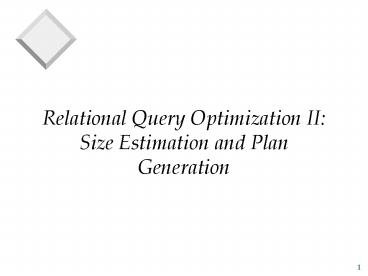Relational Query Optimization II: Size Estimation and Plan Generation
Title:
Relational Query Optimization II: Size Estimation and Plan Generation
Description:
Size Estimation and Reduction Factors Consider a query block: Maximum # tuples in result is the product of the cardinalities of relations in the FROM clause. –
Number of Views:27
Avg rating:3.0/5.0
Title: Relational Query Optimization II: Size Estimation and Plan Generation
1
Relational Query Optimization II Size
Estimation and Plan Generation
2
Size Estimation and Reduction Factors
SELECT attribute list FROM relation list WHERE
term1 AND ... AND termk
- Consider a query block
- Maximum tuples in result is the product of the
cardinalities of relations in the FROM clause. - Reduction factor (RF) associated with each term
reflects the impact of the term in reducing
result size. Result cardinality Max tuples
product of all RFs. - Implicit assumption that terms are independent!
- Term colvalue has RF 1/NKeys(I), given index I
on col - Term col1col2 has RF 1/MAX(NKeys(I1),
NKeys(I2)) - Term colgtvalue has RF (High(I)-value)/(High(I)-L
ow(I))
3
Result Size Estimation (contd)
- Selections
- Use reduction factors, logic, probability
- Often use histograms, other statistics
- Projections
- Ignore duplicate elimination (done last, if
needed) - Tuple size is reduced ? fewer pages for result
- Joins like selections, plus
- Use candidate key information
- Should consider dangling tuples
4
Relational Algebra Equivalences
- Allow us to choose different join orders and to
push selections and projections ahead of joins. - Selections
(Cascade)
(Commute)
- Projections
(Cascade)
(Associative)
- Joins
R (S T) ? (R S) T
(Commute)
(R S) ? (S R)
5
More Equivalences
- A projection commutes with a selection that only
uses attributes retained by the projection. - Selection between attributes of the two arguments
of a cross-product converts cross-product to a
join. - A selection on just attributes of R commutes with
R S. (i.e., ? (R S) ?
? (R) S ) - Similarly, if a projection follows a join R
S, we can push it by retaining only attributes
of R (and S) that are needed for the join or are
kept by the projection.
6
Enumeration of Alternative Plans
- There are two main cases
- Single-relation plans
- Multiple-relation plans
- For queries over a single relation, queries
consist of a combination of selects, projects,
and aggregate ops - Each available access path (file scan / index) is
considered, and the one with the least estimated
cost is chosen. - The different operations are essentially carried
out together (e.g., if an index is used for a
selection, projection is done for each retrieved
tuple, and the resulting tuples are pipelined
into the aggregate computation).
7
Queries Over Multiple Relations
- Fundamental decision in System R only left-deep
join trees are considered. - As the number of joins increases, the number of
alternative plans grows rapidly we need to
restrict the search space. - Left-deep trees allow us to generate all fully
pipelined plans. - Intermediate results not written to temporary
files. - Not all left-deep trees are fully pipelined
(e.g., SM join).
8
Enumeration of Left-Deep Plans
- Left-deep plans differ only in the order of
relations, the access method for each relation,
and the join method for each join. - Enumerated using N passes (if N relations
joined) - Pass 1 Find best 1-relation plan for each
relation. - Pass 2 Find best way to join result of each
1-relation plan (as outer) to another relation.
(All 2-relation plans.) - Pass N Find best way to join result of a
(N-1)-relation plan (as outer) to the Nth
relation. (All N-relation plans.) - For each subset of relations, retain only
- Cheapest plan overall, plus
- Cheapest plan for each interesting order of the
tuples.
9
Enumeration of Plans (Contd.)
- ORDER BY, GROUP BY, aggregates etc. handled as a
final step, using either an interestingly
ordered plan or an additional sorting operator. - An N-1 way plan is not combined with an
additional relation unless there is a join
condition between them, unless all predicates in
WHERE have been used up. - i.e., avoid Cartesian products if possible.
- In spite of pruning plan space, this approach is
still exponential in the of tables.
10
Example
Sailors B tree on rating Hash on
sid Reserves B tree on bid
- Pass1
- Sailors B tree matches ratinggt5,
and is probably cheapest.
However, if this
selection is expected to
retrieve a lot of tuples, and index is
unclustered, file scan may be cheaper. - Still, B tree plan kept (because tuples are in
rating order). - Reserves B tree on bid matches bid500
cheapest.
- Pass 2
- We consider each plan retained from Pass 1 as
the outer, and consider how to join it with the
(only) other relation. - e.g., Reserves as outer Hash index can be used
to get Sailors tuples - that satisfy sid outer tuples sid value.
11
Summary
- Query optimization is an important task in a
relational DBMS. - Typically optimize 1 select (query block) at a
time - Must understand optimization in order to
understand the performance impact of a given
database design (relations, indexes) on a
workload (set of queries). - Two parts to optimizing a query
- Consider a set of alternative plans.
- Must prune search space typically, left-deep
plans only. - Must estimate cost of each plan that is
considered. - Must estimate size of result and cost for each
plan node. - Key issues Statistics, indexes, operator
implementations.































